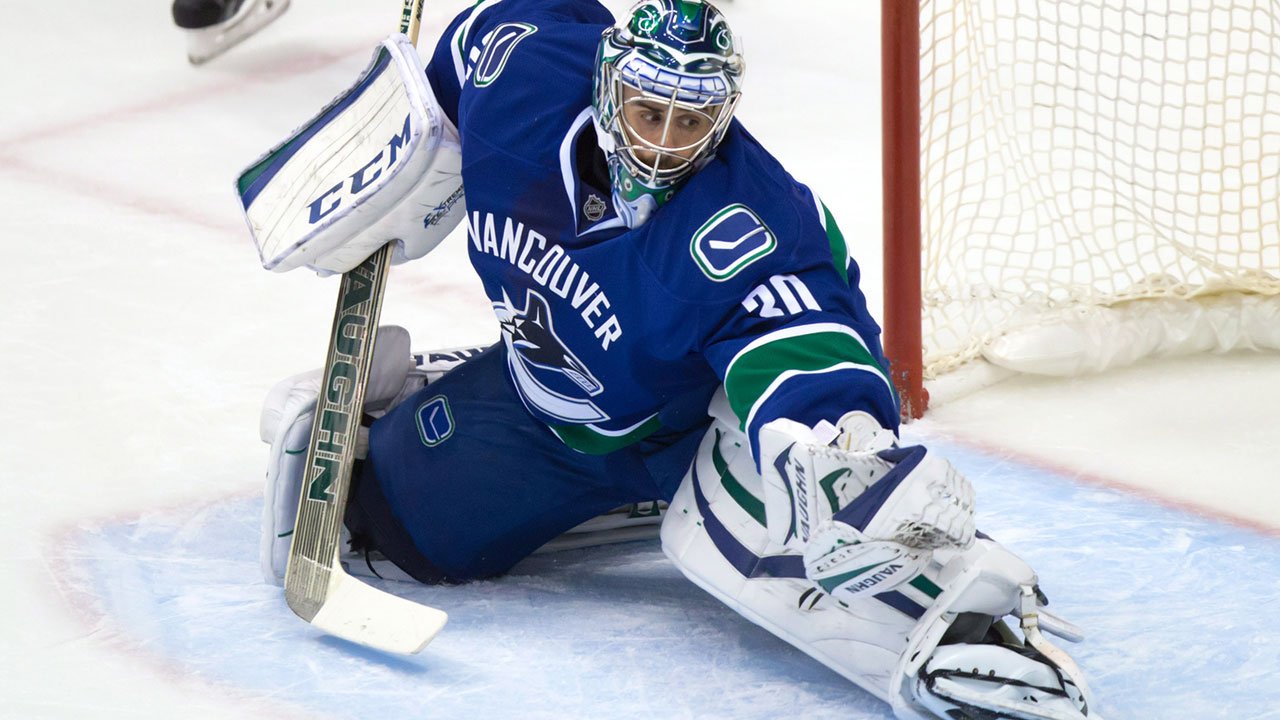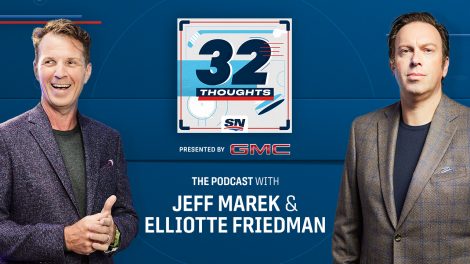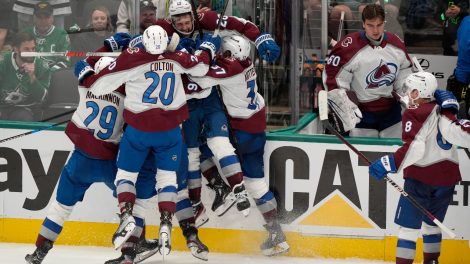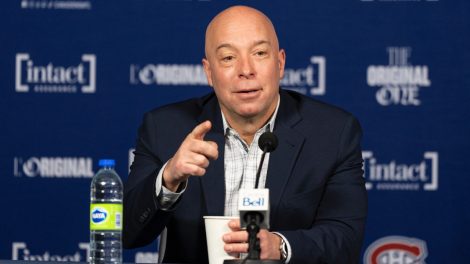This article originally appeared in Sportsnet Magazine. Available through Next Issue Canada
Six things we learned about the surprisingly successful Vancouver Canucks on the NHL’s hardest road trip
Kevin Bieksa saw an opportunity and pounced on it. Vancouver Canucks forward Chris Higgins was chatting with the press after a pre-game skate in San Jose, so Bieksa grabbed the blue gloves from his locker and silently held them up behind Higgins’s head, like Mickey Mouse ears. The scrum had only been a couple of reporters, but as Bieksa continued to dance the ears behind his teammate, TV cameras moved in and a crowd formed—a collective joke at poor, ridiculous-looking Higgins’s expense. It was a good 30 seconds before Bieksa snuck away, giggling and delighted.
This was the atmosphere in the Vancouver dressing room when I met the team at the start of a West Coast swing that pitted the surging Canucks against the Sharks, Kings and Ducks. The team was having fun, it seemed. And that was nice. Vancouver had defeated the Avalanche 5–2 in Colorado the night before and sat second in the Western Conference.
With just two losses on the season at the time, Vancouver was one of the season’s early surprises. The Canucks, after all, were one of the league’s biggest disappointments last year, finishing much closer to the bottom of the conference than the top.
But half a year and one big off-season after the bitter end of 2013–14, Vancouver seems back on top of the hockey world. Sure, it’s early. It’s very early. And yeah, the Canucks got off to a really good start last season, too, before collapsing in the New Year. But this team is different than that one. New management. A new coach. A new, Vezina-winning goalie. Revamped lines, filled with new arrivals. Even a little youth. But is the buzz just another case of unguarded optimism? There’d be no better test of the Canucks’ mettle than a road stretch against three of the best teams in hockey—all of which happen to call California home, and all of which habitually spank the ’Nucks.
So I headed to the sun-kissed coast to spend some time with the team that is suddenly the talk of the NHL. This is what I learned.
1. Don’t talk to Ryan Miller on game day
Ryan Miller stood at centre ice for three minutes during the morning skate in San Jose, crouching forward and staring down at a shark painted in the surface. Then he broke into a series of butterfly slides, back and forth on angles, carving a star into the ice surface. He headed for the dressing room, where Bieksa was pranking Higgins, and took off his gear, looking down and inward. He wiped his skates on the carpet as I stood next to him, hoping to ask about the season.
“Are you waiting for Ryan?” a media relations employee asked me. I nodded. “Ryan doesn’t talk on game days,” she said.
Miller was looking up now—but focusing inward, still. His long brown hair hung wet in front of his face. He looked like Jesus might, if he did hot yoga. Miller was in pre-game goalie mode, a unique state of being. I stood about two feet away, but he did not sense my presence at all. (Or at least he didn’t acknowledge it.) That Miller is so completely in the zone is an essential part of the Canucks’ recent success. He was one of the major signings Jim Benning made after taking over Vancouver’s front office in May, and he’s making his new GM look good.
Later that evening, Vancouver was badly outplayed by San Jose, but Miller made 34 saves in a 3–2 win. After an average season split between Buffalo and St. Louis last year, the 34-year-old appears to be the superstar the Canucks gambled he’d be. Roberto Luongo’s numbers last year are pretty much a wash with Miller’s so far this season—Lou’s are a bit better, even—but now the team has a goalie they know will be there in the spring. And Miller leads the league with 10 wins—the only stat that really matters.
His addition is about consistency and confidence. With the Luongo era behind them, Vancouver looks to finally have some stability between the pipes.
2. The twins have found a third
After a day of rest in Los Angeles, the Canucks hit the morning skate before facing the defending Stanley Cup champions, with a handful of loyal L.A.-based Vancouver fans lining the glass during the practice. Afterwards, the fans waited behind the curtains, guarded by security, hoping to catch a glimpse of the players they’ve dutifully supported despite living in a dynasty town.
One of the fans—a 10-year-old named Hunter—bolted past security when the Sedins walked past. In his mad dash for glory, Hunter managed to get one signature on his blue Roberto Luongo T-shirt. It was thrilling, until he realized: “I don’t know which one it was.” Close examination of the autograph revealed little. While the mystery will persist for young Hunter, at least one person around the Canucks can tell the twins apart.
Radim Vrbata has six goals and 13 points in 12 games on Vancouver’s top line. The 33-year-old vet says he signed in the off-season specifically for the chance to play with the dynamic, identical duo—figuring he’d fit their fluid, passing-and-possession style of play that “only they can explain.”
He was right: The twins both saw dips in production last season but look rejuvenated next to their new Czech linemate, back up around their point-per-game career standard. Vrbata himself is on pace for a career year in points. “So far,” he says, “so good.”
3. Willie Desjardins is the anti-Torts
After some tumultuous years under the management of Mike Gillis and last year’s debacle of a season under coach John Tortorella, it was clear that the team needed a change in leadership. Enter Willie Desjardins, hand-picked by new team president Trevor Linden and GM Jim Benning; exit Tortorella, the failed experiment. In personality and in his approach to the game, Desjardins, with his perfectly trimmed grey moustache and dull media presence, could not be more different than the “Torts” sideshow.
Tortorella is notoriously critical of his players, which caused tension in the Canucks dressing room. And it was no secret that his style clashed with management’s.
Desjardins, meanwhile, is in sync with the bosses, and has the Canucks players happier and more relaxed. “We’ve got a real fun, positive group in the room and a coaching staff that complements that,” says defenceman Dan Hamhuis. “They’re giving a lot of positive reinforcement—and that’s translated into a lot of guys playing with confidence on the ice.”
When Desjardins first met with his new team he had a simple, clear message: “Let’s win.” Bieksa appreciated the sentiment. “Anything less is unacceptable,” says the Canucks’ assistant captain. “Willie brings a lot of positive energy. He keeps guys motivated.”
4. Vancouver knows how to lose well
There’s nothing like a game against the defending champs to really let you know where you sit in the NHL hierarchy. The Staples Center was heavy with chants of “Miller . . . Miller . . . Miller . . . YOU SUCK!” all night, even after backup goaltender Eddie Lack relieved him in the third. The Canucks fell 5–1, thoroughly thumped by a team with two Cup banners less than four years old. Exactly the kind of team Vancouver needs to find a way to beat.
After the game, Bieksa looked like he wanted to punch someone in the face, steaming in his stall as reporters shuffled into the dressing room. The same reporters approached Miller cautiously and whispered questions in hushed, empathetic tones. He’d allowed four goals on 22 shots. It felt like a funeral.
Miller didn’t need the sympathy, though. He was one of the players who spoke up in a brief team discussion before the press arrived. He spoke about the game being over and done with, and said that those were the Stanley Cup champs right there—that the Canucks could learn a lot from the Kings, and that they could beat them. Several other players spoke up too, Bieska said (after a shower that seemed to have calmed him down). Some voiced concerns about giving up odd-man rushes and a lack of puck support in the game. It was an airing of grievances, an open forum on how to improve.
This team knows about losing, Bieksa said—and, these days, how to overcome it. That was something the Canucks weren’t able to do when everything fell apart last winter and the boys were golfing by early spring.
5. Everything old is new again
In Anaheim, against the best team in the Western Conference—and to face once-key Canuck Ryan Kesler—Vancouver was eager to show that their early success wasn’t an aberration, that this year’s vintage knew how to overcome adversity.
Bieksa got literal with the Canucks’ need to fight back after the loss in L.A., dropping his gloves with the Ducks’ Patrick Maroon at the opening faceoff. (Bieksa asked nicely—that’s the key, he says.) The fight may have been a draw, but it did what Bieksa intended: It got his teammates going.
In a show of confidence for his goaltending tandem, Desjardins gave backup goalie Eddie Lack the start against the powerhouse Ducks. Lack had been one of the last players off the ice during the team’s recent practices, working his way through an 0-3 start to the season and an .895 save percentage.
After Lack took over the No. 1 spot when Luongo was traded to Florida late last year, it seemed like a vote of non-confidence that the Canucks went out and picked up Miller in the off-season. But Lack remained characteristically cheerful and optimistic through it all.
“I’m quite comfortable in my role here,” he had told reporters. A bad loss against the Ducks could potentially have broken him—and shatter the team’s confidence in their backup goalie. But we’ll never know: Lack turned aside 28 of the 29 shots he faced in Anaheim.
And while much of the discussion this season has been about what new faces have brought the team, some guys in well-worn sweaters have found a new step in their game. Alex Burrows scored the tying goal against the Ducks—a deflection off a Hamhuis shot in the second period, evening the score at one.
It was the highlight of an all-around solid game for Burrows. After a couple of difficult seasons, the 33-year-old seems to have rediscovered his form. He has eight points so far this season. Last year he notched only 15 points in 49 games. In general, the Canucks have found some secondary scoring after relying too heavily on the twins’ line in the past.
Higgins and Linden Vey have played well. Alex Edler has been a force from the point, with three goals and seven points to lead the “D.” Special teams have led the way forward: From notably below the league average last season, the Canucks’ power play and penalty kill have been comfortably above-average this season. More importantly, the team’s win percentage has jumped from 43 to nearly 70 percent. Much of the success can be credited to Desjardins’s system, which has focused on puck possession and allowing players to trust their instincts, says Henrik Sedin. “It’s a big difference this year.”
6. There’s life after Kesler
If there was one major point of concern about the Canucks this season, it was how the team would fare without its longtime power forward, Ryan Kesler—who lost faith in the organization and asked for a change of scenery last year. That deal brought in centreman Nick Bonino and defenceman Luca Sbisa.
So far, Vancouver fans aren’t mourning the loss. Bonino has seven goals and 13 points and is fuelling the second-line offence. There was no better way to underline this point than for the Canucks to battle the Ducks to a shootout, where the spotlight could narrow itself on the two key players in the deal. The boos rocked the Honda Center when Bonino took Vancouver’s first attempt, but were hushed immediately when he slipped the puck under Frederik Andersen’s pad.
The noise rose again in support of Kesler as he had a chance to keep the Ducks alive two shooters later—but he clanged the puck off the post. He hung his head as the Canucks poured off the bench, in their biggest win of a young season, at the expense of an old friend.
Fresh off their victory over Anaheim, the Canucks were relaxed again.
“I’m just tired,” Bieksa sighed, leaning back in his stall. Burrows was across the room, still marveling at the left hook Bieksa threw to open the game. Having held off the Ducks, Lack fended off reporters. Bags were frantically packed, zipped and hauled away. The toughest run of games any NHL team can face was over, and the Canucks were walking away with two wins and a loss.
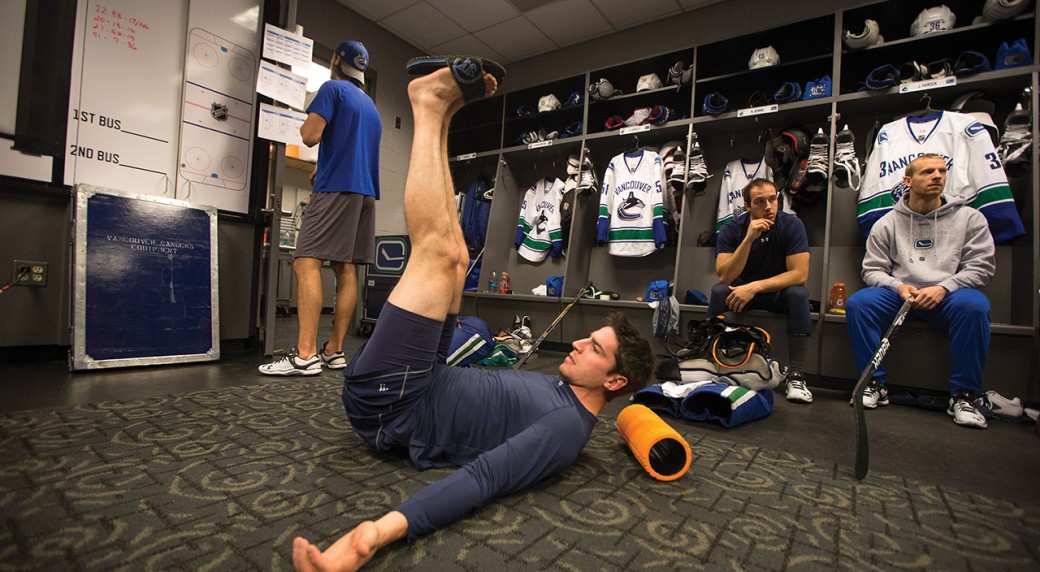
The lingering question had been answered, if only in part: Yes, this Vancouver team had it in them to beat the best. Still, it was an uneven journey along the coast. The results were scattered—a goalie’s stolen win in San Jose, a collapse in L.A. and a tight victory over the West’s top team.
Regardless, for the Canucks this trip was about making a statement—to themselves, and to the league. Job done.
As the players filtered out to the team bus, Henrik Sedin walked through the near-empty dressing room with a grin across his face. There is only one difference from last year, the captain said when asked about the team’s new identity. It’s simple, he said—and his smile grew wide.
“We’re winning . . . and it’s fun.”

